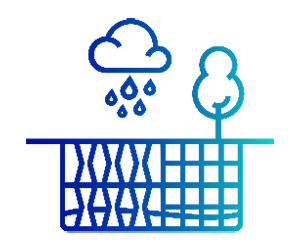
Infiltration systems include underground storm water management products, as well as treated wastewater products following biological treatment.
They are designed with the aim of improving rainwater management and mitigating flooding.
The most commonly used types of infiltration systems are underground modular tanks and infiltration tunnels.
The former provide rainwater harvesting and are suitable for a variety of applications in both natural and built environments. The aim of the system is to temporarily collect rainwater and gradually release it, preventing flooding and contributing to groundwater recharge. Alternatively, they allow the collected water to be reused in order to conserve resources.
Infiltration tunnels are underground basins for the storage and reuse of storm-water or wastewater. These systems, depending on the application and type of installation, are capable of facilitating water infiltration, releasing the accumulated water gradually or storing a defined volume of water by releasing the excess to a final receptacle.
Infiltration tunnels are also used as fields for dispersing treated wastewater from wastewater treatment plants (WWTPs).